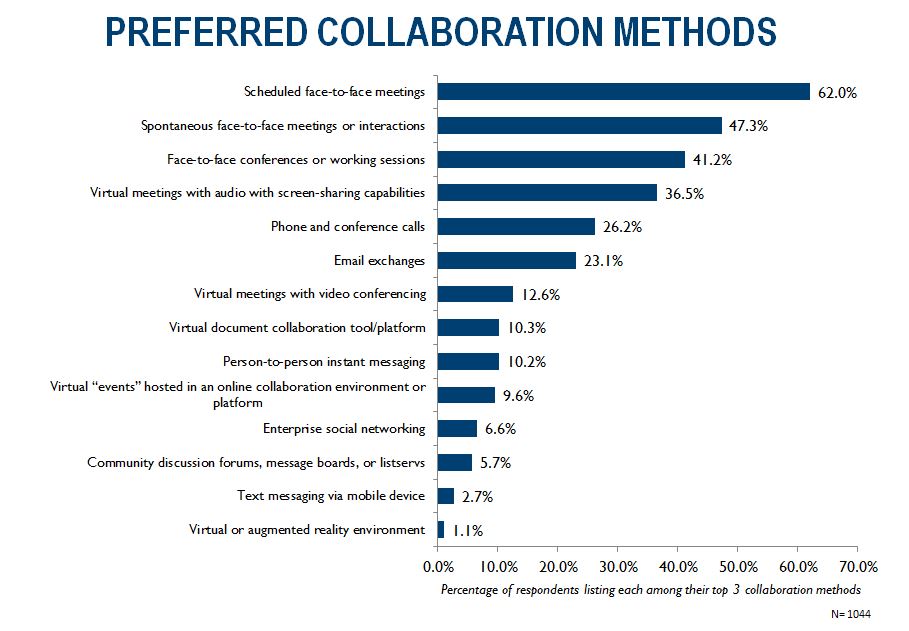What are the biggest disconnects between how people currently work and how they want to work, and what can organizations do to improve the future of work for everyone? This fall, APQC surveyed more than 1,000 people about their current work experiences and what changes would make them happier and more productive. One of the key findings is that, despite organizations’ ever-increasing reliance on virtual collaboration to power key business processes, people still prefer to be face-to-face.
According to the data, today’s workers are absolutely drowning in virtual collaboration tools and messages. Email is the most ubiquitous, with a whopping 94% of respondents using work email daily. But that’s just the tip of the iceberg. For example:
- 61% use instant messaging daily for work
- 50% use phone and conference calls daily for work
- 33% use mobile text messaging daily for work (another 24% use more than once a week)
- 27% participate in virtual work meetings daily (another 26% do more than once a week)
- 26% use video conferencing for work more than once a week
- 24% use work discussion forums or enterprise social networking more than once a week
Yet despite the array of communication options open to employees, when you ask them how they prefer to innovate and solve problems, they almost invariably point to high-touch, in-person communication channels. Scheduled face-to-face meetings top the list of favored methods, followed by spontaneous in-person interactions and face-to-face conferences/working sessions. And despite the stereotypes about Millennials preferring to text than to talk to people, these trends hold up across all three major generations currently in the workforce (Baby Boomers, Gen X, and Millennials).
What can we make of all this? To a certain extent, the desire for face-to-face contact is hardwired into the human psyche, and organizations must accept and accommodate people’s need to interact in person (at least from time to time). Travel budgets have been cut a lot lately, but when possible, it’s still important to gather virtual teams and networks in one place so that members can bond and form meaningful relationships. Even infrequent in-person meetings can yield significant benefits in terms of building trust among team members and helping them collaborate more effectively in their day-to-day virtual interactions.
But with teams becoming more geographically dispersed and all-virtual jobs becoming more mainstream, organizations also need to help people become more comfortable with virtual interactions. Part of the equation is improving the tools so that they replicate more of the immediacy, vibrancy, spontaneity, and—dare I say it?—fun of being face-to-face. (We’ve all been on calls where half the people sound like they’re underwater—why is that still happening in 2016??) However, building a better mousetrap is not enough: There are also change management issues to deal with.
Organizations must do more to make employees aware of the knowledge sharing and collaboration tools available to them, how to use them effectively, and which is best suited to a given situation (note: IT may not be the best candidate to lead this effort). Often, dislike of virtual collaboration stems from people being overwhelmed by the array of options available to them—or from people using the wrong tool for the job (e.g., asking a complicated multi-part question over email, or hosting a virtual meeting for something that could easily be resolved through IM).
Leaders also need to do a better job of conveying the value of one-to-many virtual collaboration, both to the organization as a whole and the individual employees involved. People already know what they like about being face-to-face, and convincing them to fully embrace new ways of working requires a significant shift in mindset. But given the efficiency of one-to-many communication through vehicles like communities and social networks—along with the traceability and reusability of the knowledge shared in these forums—the change is worth the growing pains. We’ve come a long way in the past 20 years, but we’re not there yet.
This is just one of many takeaways from APQC’s 2016 Envisioning the Future of Work survey. I’ll be blogging about others soon, but APQC members can get a sneak peek by downloading the survey summary report. We also have other articles and benchmarks based on the survey data coming out soon, so please stay tuned.
And if you want to network and build relationships with a network of knowledge management professionals, we encourage you to come be face-to-face with us at APQC’s 2017 Knowledge Management Conference, which will take place April 27-28 in Houston. Our theme this year is “Empowering Tomorrow’s Knowledge Workers,” so the issues from this survey will be at the top of the agenda!
